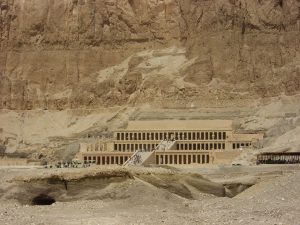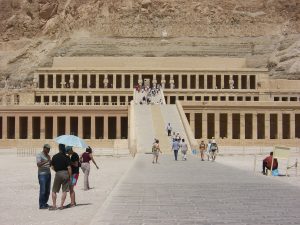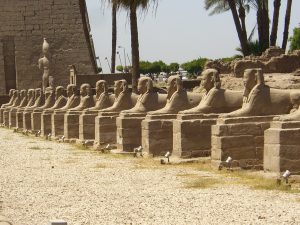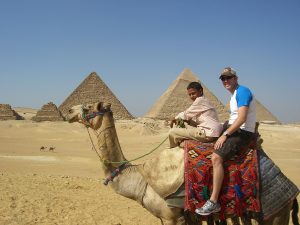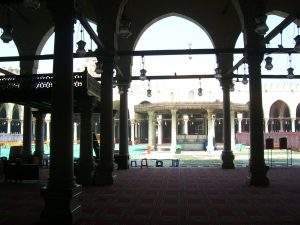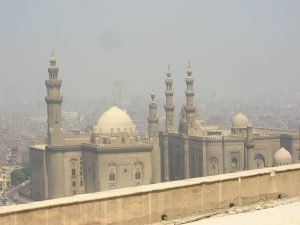Religion, Business, and History in Egypt
The Religion, History, and Business of Egypt
Being in Egypt at the time of Ramadan taught me to respect a lot of the Mulsim religion.
I spent 5 days in Egypt, on an impromptu vacation, during Ramadan. I even attempted to participate in Ramadan. I also explored the Pyramids of Giza, the Great Sphinx, the Egypt Museum, religious sites, markets, and the Valley of Kings, the Valley of Queens, and Queen Hatshepsut Temple in Luxor.
Most meaningful experience: Participating in Ramadan in the heat of the summer and understanding how it changes perspectives on food, sex, and bad thoughts.
Top tips:
- Explore Coptic Cairo and learn about its religious tolerance
- Witness the incredible Pyramids of Giza and ride a camel around the Great Sphinx of Giza
- Visit during Ramadan to experience the community atmosphere as the day’s fasting breaks
- Travel south to Luxor to explore the Valley of the Kings and the Valley of the Queens
- Take on the tactical salesmen in the Khan el Khalil market
In the summer of 2010, I was in Finland for business and decided to take a (logical?) vacation by visiting Egypt for five days during Ramadan. I have no idea why I did it but I really wanted to take a crazy trip and this had been on my list.
After arriving at 2 AM and making my way to the Novotel Airport Hotel, I couldn’t sleep. So I grabbed a cucumber yogurt dish and went to chat with the tourist agent about booking a trip to the pyramids. Not only was he up but so was the entire lobby…and seemingly everyone in the hotel. The hotel restaurant was packed with people eating a buffet.
When I asked the concierge why people were up, he told me it was Ramadan. Everyone was fasting during the day, which meant that from sunrise to sunset, one is not allowed to eat, drink, nor look at women. Then once the sun sets, the streets come to life with everyone eating, meeting their friends, and enjoying the cool evening weather.
When in Rome, act as the Romans. So I attempted to do just that.
Exploring the Pyramids of Giza
The first day I went to see Sakkara, Giza, and the Sphinx. Luckily, I met an Egyptologist who was helping another American tourist and invited me to come along. He guided me through the history of each place and created an experience that was much more valuable than had I gone it alone. I learned about why the structures were built the way they were and the theories around how they were built. Although technically, no one actually knows.
The weather in Cairo was an intense 100+ degrees and dehydration kicked in while climbing the stairs of the Darfur Pyramid, the one pyramid that can be entered. About halfway down the 100-meter-long walkway that led into the tomb, my quads went into spasms and I cramped. I had to sit down in the middle of the walkway in utter pain. In all of my running and sporting activities, I had never experienced such cramping before.
After I made it out of the tunnel (in a very slow walk), I broke my fast and drank some water. I’m just not as tough as the Egyptians…and how they built this in the heat…
After arriving in Giza, I decided to purchase what turned out to be an expensive camel ride. Camels are much more athletic and flexible than I had imagined, traversing steep sandy hills, trotting over rocky terrain, and climbing big stairs. What shocked me the most is that they can move fast and when they break into a gallop, there was little that could stop them.
My camel did just that, taking off for a gallop around the Sphinx and causing the local Egyptians to panic and run around after me (something that only worsened my anxiety). Without a saddle, it was also quite painful for a man to be riding on top. However, it did make it easy to not look at women for the rest of the day – I could easily achieve at least one of the Ramadan requirements.
When I arrived back at my hotel around 5:30 PM, I spent the next hour watching the clock, waiting for 6:30 PM when I would be able to eat again. But when the clock struck the half hour mark, I was so tired and all I really wanted to do was chug two bottles of water.
When I finally made it out for a falafel at 10 PM, it was amazing to see the streets filled with people just walking, talking, and hanging out. The community feeling was so strong that it made me somewhat envious. I wish we did something like this in our neighborhoods back home.
Discovering religious tolerance in Coptic Cairo
The following day, my Egyptologist and I went to the Egypt Museum where there were mummies that still had their hair, teeth, and toenails (sometimes painted red). While modern chemists know the chemicals used to mummify a body, they still don’t know the exact mix. Another fascinating exhibit was about King Tut who is famous because his tomb was the only one in the Valley of the Kings to be uncovered with all its treasures. Inside there were three pure gold coffins, with gems all around it and one precisely placed inside of another.
It amazed me the amount of effort that went into preparing for death in Ancient Egypt. Perhaps people should spend their lives readying for death in the way that Egyptians prepared their burial items.
After the museum, I went to explore Coptic Cairo where there was a Catholic Church (supposedly where Jesus and Mary stayed during their trip to Egypt), a synagogue, and a mosque. Christianity was the first religion in Egypt but years later, many people converted to Islam. What was interesting was how all three religious structures were built right next to one another because people believed in religious tolerance. I also learned that in Egypt, people must state their religion on their passport. It may be a tolerant country but not a private one.
We also visited the Citadel, which was one of the coolest fortresses I’d ever seen. It seemed akin to the Citadel University in South Carolina. Never a battle was fought there, so it remained mostly intact.
Negotiating with the salesmen of Khan el Khalil market
That evening, I went to explore the open-air market of Khan el Khalil where you could buy clothes, hookahs, jewelry and an assortment of things. But I got tired of being hustled for money that I, regretfully, didn’t buy anything.
Egyptians had several negotiating techniques that may be of interest to business people. First, they ask you where you are from and tell you they have relatives, girlfriends or some association with the place. This creates a common bond – a very important sales tactic.
Once they get your attention, they’ll invite you into their store to give you something, perhaps tea or a sample of their products. Once the customer accepts and has their foot in the door, they’re hooked and will commit to the purchase at any price. They did exactly that.
When I walked out the door, they started to scream emphatically. At one point, some guy grabbed me and I lifted my hand to hit him. The look on his face was ghastly but he let me go. I guess I would not make a good ambassador but I felt threatened and was really not happy with the aggression.
Another tactic was the old “bait and switch” – they negotiated in Egyptian pounds and then switched to dollars. At the end of the negotiation, they would say “I meant this is US dollars, not Egyptian pounds”. So then the negotiation would start again.
The final negotiation strategy was to serve the customer before quoting a price. They would do this for a taxi ride, horse ride or even a painting. They would force the customer to hold the painting and then tell them to take it is a present. Then as the customer walks out, the seller would yell and make the customer pay for it while refusing to accept it back. It was a very strange tactic and often resulted in some nasty conversations.
South to Luxor
The following day I went to Luxor with a friend of the Egyptologist who picked me up in a van with around 20 other tourists. We headed to the Valley of Kings, the Valley of Queens, and Queen Hatshepsut Temple. All three were spectacular.
On the trip, I met an older US military veteran of the Iraq War who was on his way back to do some peace work. He asked me: “Could you imagine fighting a war out here? Young Americans like you are doing this every day.” That truth really hit me hard.
When I returned to Luxor around 1 PM, I hadn’t eaten or drunk anything for 24 hours and had a delirious breakdown. I decided to break my fast and go to the FFF (Fast Pharaohs Food) at McDonald’s. A Pharaoh was considered higher than the Gods and liaised between the humans and the Gods. At some point in time, this changed, with the Pharaohs becoming the Kings and subservient to the Gods. Eating my Fish Fillet and Big Mac, I certainly felt like a Pharaoh. I’d only survived two days of Ramadan – how weak! Perhaps I should have eaten more at night like the locals did, instead of sleeping.
On my final day in Egypt, I walked over to the Luxor Castle and the Temples of Karnak. While both were interesting, I was drained from all the heat and commotion.
I felt that visiting the temples, pyramids and religious sites of Egypt made it a once-in-a-lifetime travel destination. Being there during Ramadan was also quite a learning experience. In the west, we are constantly inundated with food, sex, and aggression/passion. But by not looking at women and not saying bad words, you are encouraged to have a purer mind. I found a lot of value in Ramadan and will try to continue practicing its values…but hopefully not in such hot weather!
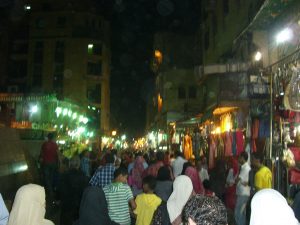
Ramadan at night in Cairo

Sunset in Luxor
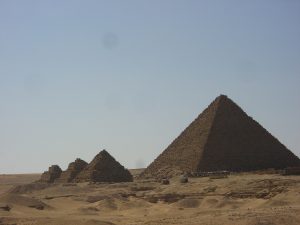
Pyramids
